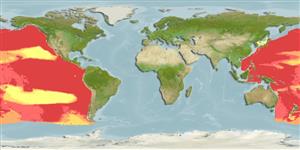>
Scombriformes (Mackerels) >
Bramidae (Pomfrets)
Etymology: Brama: Old French, breme, bresme = a fresh water fish; 1460 (Ref. 45335); japonica: Named after Japan, its type locality (Ref. 6885).
More on author: Hilgendorf.
Environment: milieu / climate zone / depth range / distribution range
Ecologia
marino; oceanodromo (Ref. 51243); distribuzione batimetrica 271 - 620 m (Ref. 50610). Subtropical; 9°C - 21°C (Ref. 33866); 66°N -
Pacific Ocean: Japan to Bering Sea, and south to Peru. Reported from the Philippines (Ref. 6956) and Taiwan (Ref. 5193). Highly migratory species.
Length at first maturity / Size / Peso / Age
Maturity: Lm 36.0, range 30 - 42 cm
Max length : 61.0 cm TL maschio/sesso non determinato; (Ref. 2850); peso massimo pubblicato: 2.7 kg (Ref. 56527); Età massima riportata: 9 anni (Ref. 56527)
Short description
Chiavi di identificazione | Morfologia | Morfometria
Spine dorsali (totale) : 0; Raggi dorsali molli (totale) : 33 - 36; Spine anali: 0; Raggi anali molli: 27 - 30. Dorsal and anal fins in adults with scales, without basal sheath of scales, and not fully depressible Interorbital space in adults strongly convex, the profile notably arched. Scales on caudal peduncle forming a graded size series with those on the bases of the midcaudal peduncle rays.
Oceanic species which occurs near the surface (Ref. 2850). Feeds on crustaceans (amphipods and euphausiids), small fishes and squid (Ref. 4563). Rarely caught inshore (Ref. 2850). Good food fish (Ref. 6885).
Eschmeyer, W.N., E.S. Herald and H. Hammann, 1983. A field guide to Pacific coast fishes of North America. Boston (MA, USA): Houghton Mifflin Company. xii+336 p. (Ref. 2850)
IUCN Red List Status (Ref. 130435: Version 2024-1)
Threat to humans
Harmless
Human uses
Pesca: commerciale; Pesce da pesca sportiva: si
Strumenti
Special reports
Download XML
Fonti Internet
Estimates based on models
Preferred temperature (Ref.
123201): 3.2 - 13, mean 9.4 °C (based on 240 cells).
Phylogenetic diversity index (Ref.
82804): PD
50 = 0.5039 [Uniqueness, from 0.5 = low to 2.0 = high].
Bayesian length-weight: a=0.01738 (0.00907 - 0.03328), b=2.95 (2.77 - 3.13), in cm total length, based on LWR estimates for this species & (Sub)family-body (Ref.
93245).
Trophic level (Ref.
69278): 4.4 ±0.3 se; based on diet studies.
Generation time: 5.9 ( na - na) years. Estimated as median ln(3)/K based on 2
growth studies.
Resilienza (Ref.
120179): Medio, tempo minimo di raddoppiamento della popolazione 1.4 - 4.4 anni (tm=4).
Fishing Vulnerability (Ref.
59153): Moderate to high vulnerability (49 of 100).
Nutrients (Ref.
124155): Calcium = 21.1 [6.7, 81.1] mg/100g; Iron = 0.541 [0.212, 1.849] mg/100g; Protein = 20.2 [18.3, 21.9] %; Omega3 = 0.366 [0.209, 0.633] g/100g; Selenium = 31.9 [15.8, 62.6] μg/100g; VitaminA = 14.3 [3.9, 53.5] μg/100g; Zinc = 0.387 [0.210, 0.862] mg/100g (wet weight); based on
nutrient studies.
